You see that picture? That’s one whole year of my junk mail. Almost 33 pounds of it. A 20 inch stack of expensive, forest-destroying, unwanted trash.
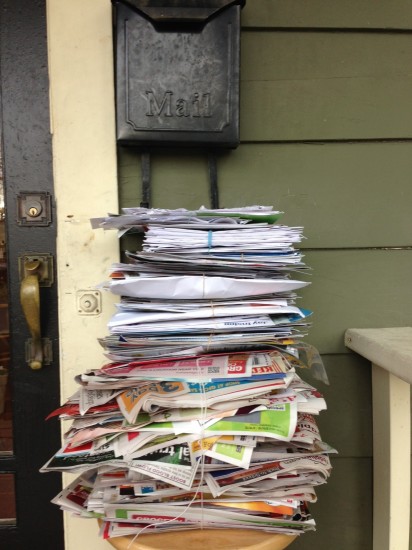
And that’s nothing! I’m five years into a crusade to defend my little mailbox from paper spam. A typical Seattle household gets three times as much: 100 pounds a year. In 2009, when I last did a 365-day count, my stack was four inches taller and weighed in at 50 pounds. That was after I’d already spent hours beating back the onslaught with the help of Catalog Choice, the de-junking website. I’ve done more of this tedious work since, opting-out online and calling customer service numbers, and I’ve pushed my tally down first to 33 pounds (for calendar year 2012) and, in the most recent six months, to the equivalent of 26 pounds per year.
Progress, yes, but it’s still an obscenity—to have to work so hard to keep other people from putting litter on my property. It’s also a drain on our communities: hauling away junk mail costs US cities and towns about a billion dollars a year.
Conclusion? Unchanged since 2009: we need a Do Not Mail Registry, just like the Do Not Call registry. Changed dramatically since 2009, however, is the overarching trend: US mail volume is in free fall. More on that below.

The big win in the stack pictured above, which shows my ad-mail from calendar year 2012, was the complete absence of phone books. From 15 pounds and six books, I went to zero. Seattle’s Yellow Pages Opt-Out program worked! Unfortunately, in my 2013 stack (which covers the six months after I spent May aggressively unsubscribing to junk mail), one small phone book appeared, from Frontier Communications. I checked Catalog Choice and saw that I’d already told Frontier to skip me. If Seattle’s Yellow Pages law were still law, Frontier could have been fined for ignoring my request. Unfortunately, the Yellow Pages industry won a court challenge, so the fines are no longer in effect. Aggravating! Naturally, I have torn up the Frontier book and folded its yellow paper into a voodoo doll. I’ve been spending evenings tossing it in the air and catching it on my ice pick.
Just kidding. (Sort of.)
I went to the industry’s own opt-out website, created in response to Seattle’s law, and sent word to Frontier again to keep its advertising pulp off my porch. Fingers crossed. (Bigger good news: Seattle’s phone book count has plummeted because of the law. Only a third as many books are now delivered in the city!) Also good about the 2012 mail pile was the fact that almost all of the repeat offenders I contacted in 2009—Eddie Bauer, Bike Nashbar, the local youth soccer association—had stopped hurling paper at me.
The bad news was that others took up where they left off. Just mention the name of one particular mailer and you’ll see me bare my fangs: RedPlum, an ad purveyor owned by Valassis Interactive, Inc., single-handedly accounted for almost half of my 2012 junk mail, completely filling the gap left by 15 pounds of missing phone books. Every week all year, I got a thick wad of full-color, loose-leaf sales pitches and coupons, fish-wrapped with a sheaf of newsprint and prone to falling apart in my mailbox or floating out of my recycle basket when I carry it to the bin. In the photo atop this article, you can see the RedPlums taking up the bottom half of the stack: more annoying even than Yellow Pages!
Every RedPlum edition I got, my junk-mail vanquishing fantasies grew more malicious: I wanted to scatter all 15 pounds of this ink-smeared invasion of privacy in a Valassis shareholder meeting, like confetti. I wanted to shred it and blow it through the HVAC ducts at Valassis HQ. I wanted to soak it, grind it, and serve it, pink-slime-like, at the Valassis annual barbecue.
You know those colorful folders in which kindergarten teachers send kids’ crayon drawings home to mom and dad? I wanted every one of those folders opened by a Valassis boss to hold a wadded gob of the ads she or he had sent to my house. Right in front might be this particularly choice wrapper.

Valassis has earned a special place in Hell, as far as I’m concerned, but it wasn’t the only new malefactor to invade my mailbox in 2012. A smidgen of my animus extends to the post office. RedPlum mailings are like advertising packets from a Sunday newspaper, and the USPS is now eager to deliver, at a newly discounted rate, such envelope-free circulars everywhere it goes. Here I am, reading my news online to avoid paper waste and carefully peeling the plastic windows off my tissue boxes so I can recycle them, and the post office—long more trusted and beloved than any other federal institution in the United States—is cutting bargains for spammers. Grrr! Similarly, late last year, the Seattle Times started competing with RedPlum by dropping a weekly pile of ads called “Sunday Market” on my stoop, even though I subscribe to the electronic edition of that paper specifically in order to avoid all the newsprint. Just four editions weighed in at 3 pounds.

What did I do? In May, I told RedPlum, through Catalog Choice, to
cease and desist
and 10 weeks later—after nine more bundles of sales pitches—the company finally complied. I phoned to unsubscribe from the Times’ Sunday Market (206-464-2121) and delivery stopped. I also targeted some long-standing offenders. I did a happy dance when I learned that Catalog Choice had added non-catalog mailers to its service. I used this expanded coverage to beg mercy from Comcast, which had sent me a cable-TV pitch every other week all year long, weighing in at a full pound all by themselves; from CenturyLink, which slipped into my box nine unctuous offers of faster Internet; and from the New York Times, which seems unable to figure out that I am a digital subscriber because I don’t want the paper. I also wrote to two local community colleges, which between them sent me a dozen course catalogs in 2012 weighing 2.5 pounds.
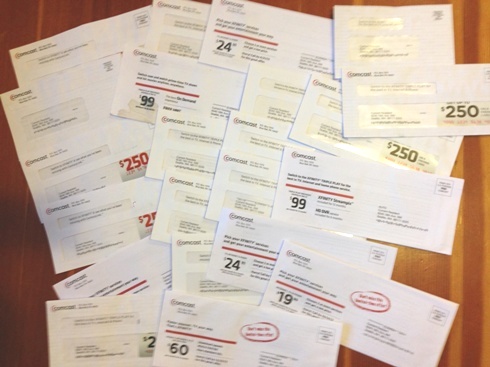
Comcast, CenturyLink, and one college all turned the spigot down or off, though the New York Times did not. As proof that no good deed goes unpunished, meanwhile, Bellevue College actually started sending me two of each catalog after I asked for relief. I’ve submitted a complaint, and the college promises to make things right. (I’m hoping the result is not quadruple mailings.)

Stamping out direct mail on your own, even with the help of Catalog Choice, makes you feel like Sisyphus. You’re never done. New intruders endlessly encroach. In the last six months, while I was watching to see if RedPlum (snarl) would leave me alone, I’ve been barraged by the League of Conservation Voters (six times), Unicef (four times), and Harper’s (seven renewal notices in six months). Meanwhile, my insurance and banking company USAA spontaneously restarted my member magazine subscription this summer, after four years of blessed reprieve. I complained this week and got a pledge of redress. I’ve also written to others (I’m looking at you Chase!), and I’m watching to see what they do.
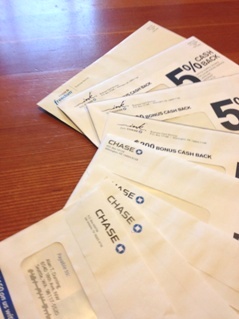
As I have said, ad mail is not the biggest of Cascadia’s challenges, but it ought to be among the easiest to solve. It’s an opportunity for regional leadership. Unwanted mail wastes paper and all the trees, energy, and climate emissions it takes to manufacture and carry 100-pound piles of junk mail to each post box each year, then recycle it again, typically unopened. It also wastes advertisers’ money, driving up costs and prices and suppressing profits.
Defending one letter slot at a time is an unwinnable war. Most people won’t even bother to fight. Individual, voluntary action is a help, but more effective solutions must operate on a larger scale. Enacting Do Not Mail registries in Cascadian states and provinces would likely spark imitation across North America, because
no one loves junk mail.
Well, almost no one.
Direct-mail advertisers—and the printers and paper companies that supply them—are not eager to let you refuse their pabulum. But I’m betting you, like me, do not care much about the likes of Valassis Interactive, Inc. Letter carriers are a more sympathetic lobby. Is their livelihood at stake?
Yes and no. In 2009, my Going Postal comment string was full of postal workers worried about a mass opt-out from junk mail. Since then, the US Postal Service’s finances have gone from bad to worse, and layoffs have ensued. In 2012, the USPS appears to have lost almost 10 cents on every piece of mail it delivered, the largest operating loss in the service’s history, as shown in this chart of profits from 1950 to 2012. (Data here.)
The post office has responded by marketing and discounting itself aggressively to advertisers, and by cutting service. More hard times are undoubtedly ahead.
Postal workers’ jobs are indeed in jeopardy, and I’m concerned for the workers and their families, but the cause of that plunging profit line is not that too many people are refusing junk mail. It’s not junk-mail warriors like me, armed with Catalog Choice, that pose an existential threat. We like the post office and wish it well. (We might, on the other hand, idly wish Valassis would hemorrhage $15 billion in a year, as the USPS did last year). The threat is the Internet—you’ve heard of it? It is eviscerating snail mail, not only for advertising but also, and especially, for bills, newsletters, and letters. This chart shows the total number of pieces of mail the USPS delivered each year from 1950 to 2012 (data here).
Growth was modest from 1950 to about 1980, and then junk mail exploded. After 2007, however, mail volume looked south and then stampeded in that direction, dropping by a quarter in just five years. Total mail has sunk to 1988 levels. There’s no reason to think it won’t keep declining. Conveying information on paper is expensive. It’s also slow. No wonder people are moving online. As a side effect, they’re helping the environment. Paper is among the most energy-intensive and polluting products to manufacture, and hauling it around gobbles more energy.
Still,
some sort of postal service
is needed for carrying things like legal notices and absentee ballots, and the mail sure facilitates commerce, for schlepping products. (Though Amazon is purportedly developing drones to airlift you your foot cream.) Plus, who doesn’t hope for an old-fashioned love letter now and again? Surely, though, a postal service can survive at the mailing levels of yore.
As shown below (data from here and the US census), in 1950, each American received six pieces of mail a week, on average, and the post office did fine. The United States was, in fact, a fairly prosperous and civilized nation at the time. By 1980, as junk mail achieved lift off, the figure had risen to about eight pieces per person per week. In 2005, that number peaked at 14. It’s fallen back down to under 10. The post office survived in 1950, as it did in all previous decades, so it’s hard to see why it couldn’t survive a future in which it delivers perhaps five or six pieces of mail per person per week instead of 14.
I’m not qualified to MBA the USPS, but a few things seem obvious. A postal service for the information age may deliver less often. It may be more automated (even without drones). Remote residents might need to pick up their mail at the post office, as they did in bygone days. It will certainly carry fewer tons of mail, and it will likely charge higher rates. Letter carriers, freighted with fewer pieces, will travel longer routes. Perhaps they’ll return to pedaling two-wheelers, as they do already in three communities in Florida and Arizona; in New Zealand, some 80 percent of “Posties” bike their routes. The post office may even require a modest subsidy from the Treasury again, as it regularly received in the United States until 1982. (In fact, only in 24 of the last 87 years has the post office earned as much as it spent—I counted.)
Giving ourselves the power, through a Do Not Mail registry, to stop the deluge of RedPlums, Chase Visa Gold offers, and Comcast pitches is not a threat to the postal service. Opting out of mailings that do not interest you actually improves the profitability and cost-effectiveness of advertisers’ efforts. You weren’t going to buy anything from Crate & Barrel anyway, so excising you from the list just saves C&B money. The company can then afford to pay slightly higher postal rates.
The immediate challenge is the Internet, and adapting to it will reshape mail service profoundly. But—hello?—isn’t that sort of, well, expected?! It’s not called the “Digital Revolution” because everything stays the same. Along the way, why not let the Internet improve our control over what we receive? That’s the point of Catalog Choice.
In fact, why couldn’t the post office have thought of that? If it had, or if we had a Do Not Mail registry already, or even if regulations simply required mailers to honor requests channeled through third-party services such as Catalog Choice, this junk-mail warrior wouldn’t be baring his fangs, raging at phone booksters, or fashioning voodoo dolls in his mind. Instead, I’d just open my mailbox and find things I actually appreciate receiving.
On December 1, I started a new pile of junk mail. I’ll report back. I’m hoping that I’ll have more encouraging news next year—and not one stinking RedPlum.

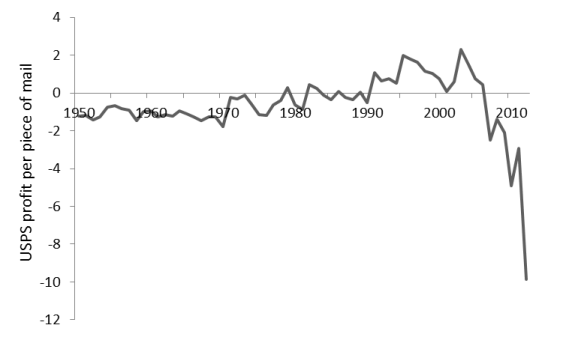
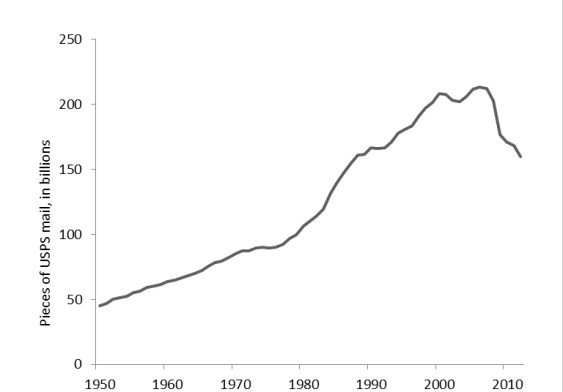
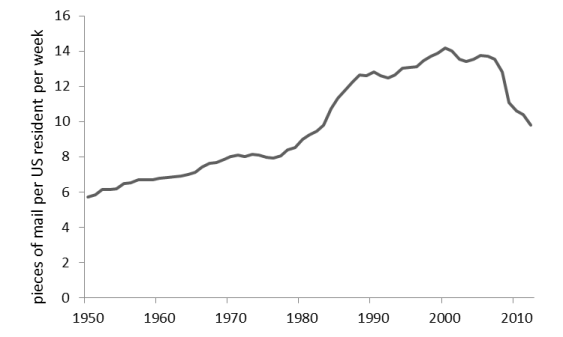

Comments are closed.